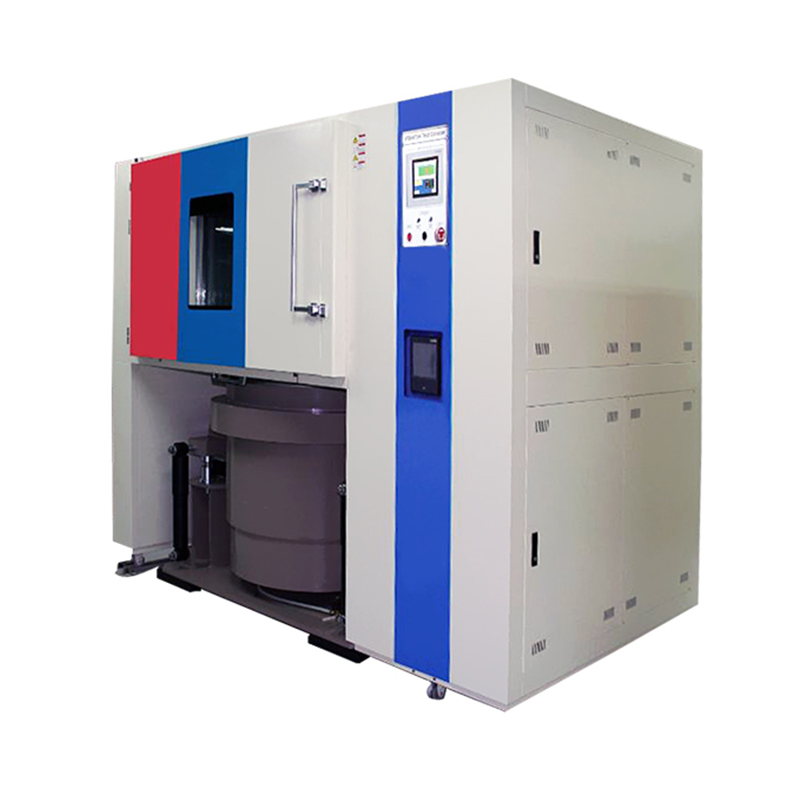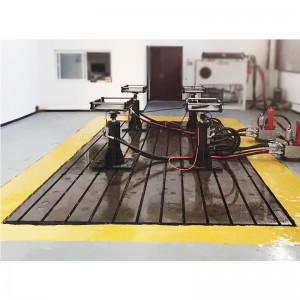Temperature humidity vibration combined environmental test system
Structure and Materials
1. Inner box material: mirror stainless steel plate (SUS 304 thickness 1.0mm);
2. Outer box material: stainless steel (thickness 1.0mm);
3. Insulation layer design: effectively avoid condensation on the top of the box;
4. Thermal insulation layer: thermal insulation layer (hard Polyurethane foam, 100mm thick);
5. Box door: single-piece door, single window, left open. Flat recessed handle, back button: SUS #304. The double-channel heat insulation is tight and airtight, effectively isolating the heat exchange inside and outside the box;
6. Observation window: three layers of vacuum glass, easy to observe the test sample.
7. Window anti-sweat: electric heating device to prevent moisture condensation;
8. Lighting design: high-brightness window lighting energy-saving lamps, easy to observe the test product;
9. Test hole: The left side of the body is 50mm in diameter, with 1 stainless steel hole cover and 1 silicone plug (optional multiple or 100mm);
10 machine pulleys: easy to move (adjust the placement position) and use with strong bolts (fixed position);
11. Box built-in racks: 2 pieces of stainless steel SUS #304 square punched steel racks and 2 sets of rails (adjust the spacing);
2. Temperature electric heating circulation system:
1. Heating system spinning: heat dissipation annular electric heater;
2. Heating pipe: adopts all stainless steel seamless casing, the insulation resistance is greater than 50MΩ, and has anti-dry burning control;
3. Circulation system: The wind adopts a multi-blade centrifugal rewinding fan, the shaft is strengthened, and the blades are made of aluminum alloy with high and low temperature resistance.
4. Air deflector design: It can be adjusted up and down to ensure uniform distribution of temperature and humidity;
5. Control method: Balance temperature control system (BTHC), control SSR solid state relay in P.I.D. mode to achieve high-precision non-contact switch control, so that the heating and humidifying amount of the system is equal to the amount of damp heat loss, so it can be used stably for a long time.
Refrigeration system:
1. Refrigeration system: original French Taikang compressor (determine the power according to the low temperature range);
1.1 Overview: The heart of the compressor refrigeration system adopts the refrigeration cycle of compression→condensation→expansion→evaporation (heat absorption),
thereby reducing the ambient temperature.
1.2 Structure: A. Shell B. Motor C. Cylinder D. Piston
E. Starter and thermal protector F. Cooling system composition
1.3 Features:
A. Large volume F-class insulated motor with high efficiency and low slip rate ensures high cooling capacity, low power consumption and safe operation
sex.
B. Series 1/12-12 horses, ten series, hundreds of models. The most prestigious in the commercial freezer industry.
C. Long-term application under different climatic conditions in different regions of China and Southeast Asia, proven, stable and reliable performance.
D. The best balance design makes the compressor less vibration, low noise and more stable operation.
E. Wide voltage design, single camera working voltage 180-240V, three cameras 340-440V, suitable for Chinese voltage requirements.
2. Cold and heat exchange system: Ultra-high efficiency SWEP refrigerant cold and heat exchange design (environmentally friendly refrigerant R404A);
3. Heating load adjustment: automatically adjust the refrigerant flow to effectively take away the heat emitted by the heating load;
4. Air-cooled condenser: fin type with cooling motor;
4.1 Overview: The air-cooled condenser is a heat-dissipating device that uses air for cooling, which is matched with Freon refrigeration equipment.
4.2 Features:
A. The shell is made of high-quality steel plate, the surface is sprayed, corrosion-resistant, beautiful in appearance, high in strength, corrosion-resistant, and easy to assemble and combine.
B. Adopt high-efficiency external rotor fan with low speed and large air volume. Smooth operation and low noise.
C. Independent switch, safe and convenient. The fan motor has high waterproof performance (IP65) and long service life.
D. The copper tube adopts high-purity seamless red copper tube, which has a long service life and is not easy to crack and corrode.
E. The contact surface is large, which enhances the strength of the fins and the effect of air turbulence.
F. Applicable to refrigerants such as R22\R134A\R404A\R407C
5. Finned evaporator: finned multi-stage automatic load capacity adjustment;
5.1 Overview:
The evaporator is a very important part of the four major components of refrigeration. The low-temperature condensed gas passes through the evaporator to exchange heat with the outside air, liquefy and absorb heat, and achieve the effect of refrigeration.
5.2 Structure:
It is mainly composed of heating chamber and evaporation chamber. The heating chamber provides the liquid with the heat required for vaporization, and promotes the liquid to boil and vaporize;
The hair chamber makes the two phases of gas and liquid completely separate. The steam generated in the heating chamber contains a large amount of liquid foam. After reaching the evaporation chamber with a larger space, these liquids can be separated from the steam by the action of self-condensation or demister. Usually the demister is located at the top of the evaporation chamber.
5.3 Features of operation:
In engineering, the evaporation process only separates part of the solvent from the solution, while the solute remains in the solution. Therefore, the evaporation operation is a process of separating the volatile solvent from the non-volatile solute in the solution. Since the evaporation rate of the solvent depends on the heat transfer rate, the evaporation operation is a heat transfer process, and the evaporation equipment is a heat transfer equipment. However, compared with the general heat transfer process, the evaporation operation has the following characteristics:
A. The boiling point of the solution increases:
Since the solution contains non-volatile solutes, at the same temperature, the vapor pressure of the solution is smaller than that of the pure solvent, that is,
Under the same pressure, the boiling point of the solution is higher than that of the pure solvent, and the higher the concentration of the solution, the more significant this effect is.
B. Material and process characteristics:
During the concentration process of materials, solutes or impurities often deposit and crystallize on the heating surface to form a scale layer, which affects heat transfer;
Quality is heat-sensitive, and it is easy to deteriorate if it stays at high temperature for too long; some materials are more corrosive or have higher viscosity and so on.
C. Energy recovery:
The evaporation process is a solvent vaporization process. Since the latent heat of solvent vaporization is large, the evaporation process is a unit operation with large energy consumption. therefore,
Energy saving is an important issue that should be considered in evaporation operations.
6. Other accessories: Danish filter drier, Japan Saginomiya solenoid valve
7. System features: automatically switch the flow of the refrigeration system according to different working conditions, cut off redundant systems in a constant section to maintain energy-saving operation, and control the combination of multi-stage evaporators for cooling to obtain more uniform and efficient cooling exchange efficiency and cooling output; flow control Automatically adjusted by their respective matching solenoid valves;
Control System:
Original imported from South Korea, all Chinese LCD 7-inch LCD touch panel, screen dialogue type input data, temperature and humidity can be programmed at the same time, curve display, set value / display value curve. Support U disk to directly export temperature and humidity record data, can display various alarms respectively, when a fault occurs, the fault can be displayed on the screen to eliminate the fault and eliminate misoperation. Multiple groups of PID control functions, precise monitoring functions, and displayed on the screen in the form of data
Features
1. In order to ensure the strength, the test box adopts the overall frame welding to ensure that the box body is not deformed
2. Shakers of different specifications and models can be selected, and different seals are provided according to the connection head and connection method of the vibration table.
3. To ensure that the test box and the shaking table are completely sealed during the three-integrated work, and the shaking table has good mechanical transmission characteristics;
4. The bottom of the test box is equipped with slide rails, which can be separated from the vibration table. When the test is required, the vibration table and the test box can be tested separately
5. Has a wide temperature and humidity control range
6. The balanced temperature and humidity adjustment method is adopted, which is a high-precision, stable temperature and humidity controller.
7. Using Japan or South Korea original high-precision programmable temperature and humidity controller, 7-inch true color touch screen operation, equipped with a 10m/100m Ethernet interface, and random operating software.
8. The imported refrigeration compressor is adopted, and the refrigeration adopts a new cold end output control. Compared with the traditional cold and heat balance, it greatly saves energy consumption and reduces the customer’s use cost.”
| Parameter | |
| Maximum sinusoidal excitation force | 3200Kg.f peak |
| Maximum random excitation force | 3200Kg.f r.ms |
| Maximum shock excitation force | 6400Kg.f peak |
| Frequency range (no load) | 2~2000Hz |
| Maximum displacement | 51mm p-p |
| Maximum speed | 2m/s |
| Maximum acceleration | 100G(980m/s2) |
| 5G (50 m/s2) | 190kg |
| Maximum load (sine) F=M.A | 10G (100 m/s2) |
| 20G (200 m/s2) | |
| 30G (300 m/s2) | |
| Frequency | 2000Hz±5% |
| Payload | 300kg |
| Vibration isolation frequency | 2.5Hz |
| Moving coil diameter | Ф335mm |
| Moving coil quality | 30kg |
| Countertop screws | 17×M10 |
| Studio size D×W×H | 800*800*800mm (width*height*depth) |
| Dimensions D×W×H | About 1800*2250*1700mm (W*H*D) |
| Temperature range | -40℃~180℃ |
| Humidity range | 20%-98% |
| Temperature fluctuation | ≤±0.5℃ |
| Temperature uniformity | ≤±2℃ |
| Temperature fluctuation | ≤±3%R.H. |
| Temperature uniformity | ≤±3% |
| Heating rate | About 3.5℃/min (no-load nonlinearity) |
| Cooling rate | About 1℃/min (no-load nonlinearity) |









